
by Max F. Perutz
1962 Nobel Laureate in Chemistry
Haphazard growth
On a summer day in the late fifties a delegation from the Soviet Union appeared in Cambridge demanding to see the “Institute of Molecular Biology”. When I took them to our shabby prefabricated hut in front of the University Physics Department, called Cavendish Laboratory after its nineteenth century benefactor, they went into a huddle until finally one of them asked me: “And where do you work in winter?” They wanted to know how I had planned our successful Research Unit, imagining that I had recruited an interdisciplinary team as Noah had chosen the animals for his ark: two mathematicians, two physicists, two chemists, two biochemists and two biologists, and told them to solve the atomic structure of living matter. They were disappointed that the Unit had grown haphazardly and that I left people to do what happened to interest them.
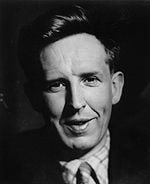
John Desmond Bernal, the discoverer of X-ray diffraction from protein crystals.
Photo: Courtesy of Prof. Max Perutz, The Medical Research Council Laboratory of Molecular Biology
Proteins were black boxes
In 1936, when I joined J. D. Bernal’s Crystallographic Laboratory as a graduate student from Vienna, it was a small, dingy sub-department of the famous Cavendish Laboratory headed by Ernest Rutherford, the discoverer of the atomic nucleus, who was regarded as the world’s greatest experimental physicist. On the other hand, I was trained as a chemist, and my interests grew in another direction. It had just been discovered that all chemical reactions in living cells are catalysed by enzymes and that all enzymes are proteins. Genes were also believed to be made of proteins, but next to nothing was known about the structure of proteins, let alone their mechanism of action. They were black boxes. Protein structure therefore seemed to be the central problem of biology, and X-ray crystallography was the only method in principle capable of solving it.
Haemoglobin enters the scene
Haemoglobin was easily available and happened to be one of the very few proteins to have been crystallised. In an early attempt at finding something out about the species specificity of proteins, two scientists at the Carnegie Institute in Washington had published a comprehensive atlas of haemoglobin crystals of different animals (Reichert & Brown 1909). In 1937, when I began the X-ray analysis of haemoglobin crystals, so little was known about it that every morsel of structural information was a gem. The Cambridge respiratory physiologist Joseph Barcroft once remarked that all that was known about haemoglobin could be written on the back of a postage stamp. My first results showed that it was a spheroid with a well-defined atomic structure, a new concept when proteins were still widely regarded as woolly colloids, that it consisted of two identical halves which were not penetrated by diffusible electrolytes, and that its four haems were roughly parallel to each other. The problem was how to get further.
Two strokes of luck
Rutherford died in 1937, and W. L. Bragg, the founder of X-ray analysis, succeeded him as Cavendish Professor. This was a blow to the atomic physicists in the Laboratory, but extremely lucky for me. Bragg was fascinated by the idea that X-ray analysis, which he had started with the determination of the sodium and chlorine positions in common salt, might be extended to the immensely complex molecules of the living cell. When my money ran out after Hitler’s annexation of my native Austria, he obtained a grant from the Rockefeller Foundation for my support which saved my scientific career. It continued until the mid-sixties and was to prove crucial for the success of our Research Unit.
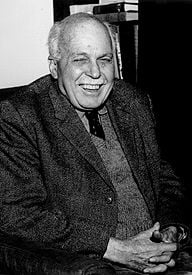 |
| Sir Lawrence Bragg, around 1965. Photo: Courtesy of Prof. Max Perutz, The Medical Research Council Laboratory of Molecular Biology |
Towards the end of the war, Bragg recommended me for a University Lectureship, but the mills of Cambridge University grind slowly, and it took nine years to materialise. On the other hand, the Rockefeller Foundation considered that the University rather than they, should pay my salary, and I found myself out of a job. John Kendrew had joined me in 1945 and had started a comparative X-ray study of adult and foetal sheep haemoglobin, a grossly premature project for the state of X-ray analysis in those days. He had a grant for two years, but nothing after that.
From this bleak outlook we were rescued by another of Cambridge’s great scientists, David Keilin, the genial, Russian-born biologist who had discovered the cytochromes and headed the Molteno Institute of Parasitology. He had given Kendrew and me bench space in his biochemistry laboratory for the preparation of our crystals and was keenly interested in all haem proteins, including haemoglobin.
Foundation of the medical research unit for molecular biology
Keilin was friendly with Sir Edward Mellanby, the formidable head of the Medical Research Council (the British equivalent of the National Institutes of Health), and he suggested that Bragg should apply to Mellanby for support. This was duly granted in October 1947 and was the turning point in our fortunes. The Council established a “Research Unit for the Study of the Molecular Structure of Biological Systems”, a mouthful which we changed later to “Molecular Biology Unit”, with Kendrew and me as its founding members. The subject became a magnet for the attraction of talent. Francis Crick, Hugh Huxley and Jim Watson were among the first to join us. Vernon Ingram came from London, Sydney Brenner from Johannesburg, Paul Doty, Alex Rich, Seymour Benzer and many others from the United States. By 1956, the Unit had grown so large I spent my time scrounging for a little bench space in a butterfly museum here or the abandoned cyclotron room there, and toyed with the idea of asking the Medical Research Council to build us our own laboratory. On the other hand, though my introduction of the method of isomorphous replacement with heavy atoms had made the solution of protein structures possible in principle, none had yet been solved. Watson & Crick’s mechanism of replication of DNA, though highly plausible, was still unproved; and we were too weak in biochemistry to qualify as an interdisciplinary laboratory, a concept yet to be invented.
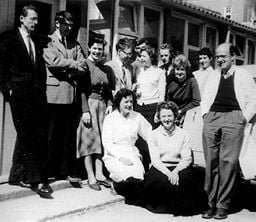
Perutz and other members of the Medical Research Council Unit for Molecular Biology outside the hub next to the Cavendish Laboratory in Cambridge where the Unit was housed from 1956 to 1962.
Photo: Courtesy of Prof. Max Perutz, The Medical Research Council Laboratory of Molecular Biology
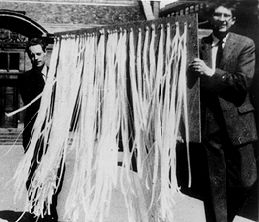 |
| Bror Strandberg and Richard Dickerson outside the hub with the output from the electronic digital computer Edsac II. The pictured tapes specified the phases of the X-ray reflections used to calculate the first atomic model of a protein; sperm whale myoglobin. Photo: Courtesy of Prof. Max Perutz, The Medical Research Council Laboratory of Molecular Biology |
The Laboratory of Molecular Biology comes into being
That situation was transformed in 1957 when Kendrew’s first low resolution structure of myoglobin emerged, when Matthew Meselson proved that each of two DNA daughter double helixes was made up of one parent strand and one newly synthesised strand, and Arthur Kornberg showed that the base sequence of the newly synthesised strand was complementary to that of the parent strand, exactly as Watson & Crick had predicted. Most important, Fred Sanger in the University Department of Biochemistry had just completed the amino acid sequence of insulin, the first sequence of a protein to be determined, and he agreed to join us.
I submitted a report on Recent Advances in Molecular Biology together with plans for the new laboratory to the Medical Research Council. When I was invited to present this to a meeting of the Council, I spent a sleepless night worrying how it would be received, but as soon as I entered the Council room, one of the members told me that it was the most interesting report he had ever read and, to my relief and delight, the Council approved our plans that same day.
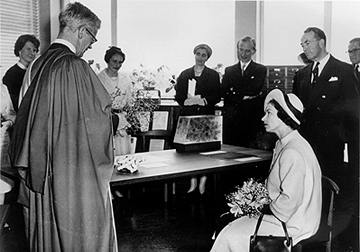
John Kendrew demonstrating his model of myoglobin to the Queen at the opening of the Laboratory of Molecular Biology in May 1962. In the back (from left to right): Mavis Bhow, Gisela Perutz, Lady Himsworth, Sir Harold Himsworth and Sir William Shawcross.
Photo: Courtesy of Prof. Max Perutz, The Medical Research Council Laboratory of Molecular Biology
The Laboratory of Molecular Biology was built next to, and simultaneously with, a new hospital south of Cambridge, initially with a floor area of 22,000 sq. ft. We moved in in February 1962, and in May the Queen came to open it. Crick and Brenner stayed away because they disapproved of royalty, but Watson came specially from Harvard in order to be presented. When we proudly showed the Queen and her party the atomic models of DNA and myoglobin, one of her Ladies-in-Waiting exclaimed: “Oh, I had no idea we have all those little coloured balls inside us!”
It was a merger
In business jargon the laboratory would have been called a merger, because four groups joined to bring it into being: Fred Sanger’s from the Cambridge University Biochemistry Department; Kendrew’s, Crick’s and my groups from the Cavendish Laboratory; Aaron Klug‘s from Birkbeck College and Hugh Huxley (on his own) from University College, London. Cesar Milstein arrived from the Argentine to join Fred Sanger soon afterwards. The laboratory started with about thirty scientists employed by the Medical Research Council and a roughly equal number of graduate and postdoctoral students and visitors. By now it houses about a hundred scientists paid by the Medical Research Council, fifty paid from other sources and a hundred students and visitors. Initially, the Laboratory comprised three divisions: Protein and Nucleic Acid Chemistry under Sanger, Molecular Genetics under Crick and Brenner, and Structural Studies under Kendrew and me. By now, Molecular Genetics has become Cell Biology, Protein and Nucleic Acid Chemistry includes Immunology and a new Division of Neurobiology has been added. We are also closely linked to Alan Fersht’s and Greg Winter’s Protein Engineering Laboratory.
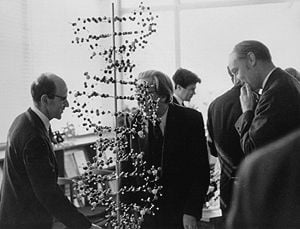 |
| Perutz, Bernal and Crick at the opening of the Laboratory of Molecular Biology in May 1962. In the center the double helical model of DNA. Photo: Courtesy of Prof. Max Perutz, The Medical Research Council Laboratory of Molecular Biology |
How the laboratory was governed
Since there was no difference in age or distinction between us, I persuaded the Medical Research Council to appoint me Chairman of a Governing Board rather than Director, the Board to be made up of Crick, Kendrew, Sanger and myself. This arrangement reserved major decisions of scientific policy to the Board and left their execution and financial responsibility vis-à-vis the Medical Research Council to me. The Board met only rarely when such decisions needed to be taken. This worked smoothly and left me free to pursue my own research. Seeing the Chairman standing at the laboratory bench or the X-ray tube, rather than sitting at his desk, set a good example and raised morale. The Board never directed the laboratory’s research, but tried to attract, or to keep, talented young people and gave them a free hand. My job was to take an interest in their research and to make sure that they had the means to carry it out.
Importance of good technical facilities
I was able to do this thanks to our excellent technical facilities. Shortly after the foundation of our Research Unit, Kendrew and I asked the Medical Research Council for funds to appoint an engineer, D.A.G. Broad, to design an X-ray tube with a rotating anode. His design provided us with a beam ten times stronger than the commercial tubes then available. Together with the precision cameras bought for us in America by the Rockefeller Foundation, it equipped us better than anyone else in the field and made possible the solution of the first protein structures. This early experience and also the technical facilities we enjoyed at the Cavendish Laboratory made us decide to equip our new Laboratory of Molecular Biology with large mechanical and electronic workshops for the development of new instruments, as if it were a physics lab. We also included a photographic workshop and stores to provide all routine chemicals and supplies, thus avoiding delays in delivery. Finally, we appointed a service engineer to keep instruments in running order, rather than having to rely on firms to send us their own service men. These facilities were, and they still are unique, and they allow people to get on with their work faster than anywhere else I know.
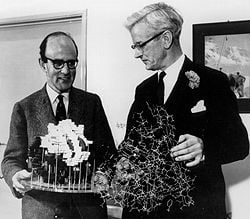
Max Perutz (left) with his model of haemoglobin and John Kendrew with his model of myoglobin in 1962.
Photo: Courtesy of Prof. Max Perutz, The Medical Research Council Laboratory of Molecular Biology
Making people talk and listen to each other
Experience had taught me that laboratories often fail because their scientists never talk to each other. To stimulate the exchange of ideas, we built a canteen where people can chat at morning coffee, lunch and tea. It was managed for over twenty years by my wife, Gisela, who saw to it that the food was good and that it was a place where people would make friends. Scientific instruments were to be shared, rather than being jealously guarded as people’s private property; this saved money and also forced people to talk to each other. When funds ran short during the building of the lab, I suggested that money could be saved by leaving all doors without locks to symbolise the absence of secrets.
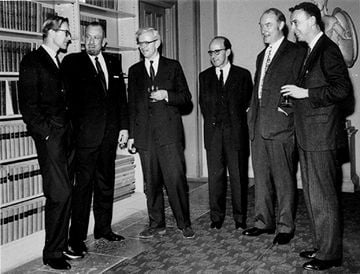 |
| Left to right: Maurice Wilkins, John Steinbeck, John Kendrew, Max Perutz, Francis Crick and Jim Watson after the Nobel Ceremony in Stockholm in December 1962. Photo: Courtesy of Prof. Max Perutz, The Medical Research Council Laboratory of Molecular Biology |
For most mortals, the Cavendish Professor of Physics used to be approachable only through his secretary’s office. To do away with this barrier I ensured that the door of my office opened directly into the passage, so that anybody could just walk in. Once a foreign visitor did so unannounced and asked: “Can I give you a lecture?” When I replied: “No, thank you, not just now”, he proceeded to give it, proudly demonstrating his diagrams on cards, instead of slides, to his captive audience.
Most laboratories hold seminars where its scientists report their work, but they are often attended only by those scientists’ own group. To ensure that everyone is aware of all the work in the lab, Crick instigated an annual week of seminars which used to be known as Crick Week, to be attended by all members of the laboratory. He used to dominate it by his searching questions and sharp comments, and it was a sad day when he left us for the Salk Institute in La Jolla.
Enlightened policies
The laboratory owes much of its success to the enlightened policies of the Medical Research Council, especially to Harold Himsworth, its secretary from 1949 to 1968, whose foresight and courage led him to support our early work for many lean years when we had little to show for it yet, and when there was only the faintest hope of it ever benefiting medicine.
Himsworth’s staff did not burden us with bureaucratic rules and futile floods of paper, but saw it as their prime responsibility to help us carry out our research. I reported directly to Himsworth, rather than a Committee; he negotiated the annual grant to the Medical Research Council with the Treasury directly, rather than being allotted the Council’s slice of the overall science budget by a ministerial committee, and he had the authority to take decisions within the broad lines of policy laid down by the Council. This system ensured smooth and efficient running, but Thatcherism has now destroyed much of it. Under her all-pervasive rule and in the name of “accountability”, bureaucracy has multiplied and directors are burdened with mountains of paperwork that leaves them less time to devote themselves to scientific work, the talent for which (and not for filling in forms) earned them their positions in the first place.
Amazing productivity
Fortunately, none of this has so far affected the amazing productivity of the Laboratory of Molecular Biology. Under Aaron Klug, its director since 1986, the laboratory has remained a magnet for talent from all corners of the world, and young as well as not so young scientists continue to solve problems that would have been considered beyond the reach of science only a short time ago. Some of these, such as Nigel Unwin’s structure of the acetylcholine receptor, or Richard Henderson’s atomic model of bacteriorhodopsin, or John Walker’s mitochondrial ATPase structure, have required sustained efforts lasting many years and could never have been solved if we had had to depend on short-term grants. Best of all, some of our work is now finding applications in practical medicine, thus justifying Himsworth’s early faith in molecular biology’s future.
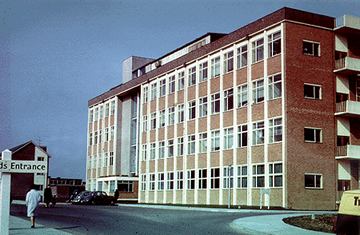
The Medical Research Council Laboratory of Molecular Biology when it was opened in 1962.
Photo: Courtesy of Prof. Max Perutz, The Medical Research Council Laboratory of Molecular Biology
First published 1 July 1997